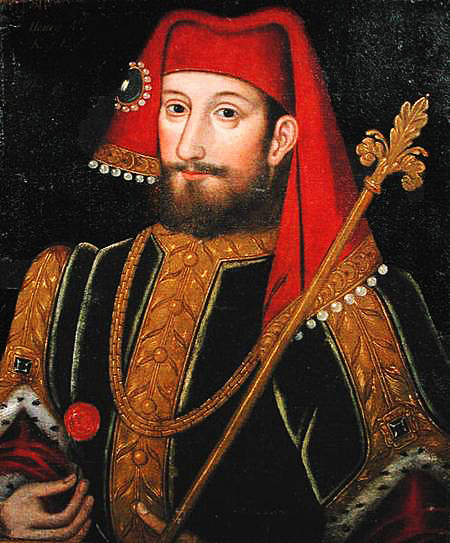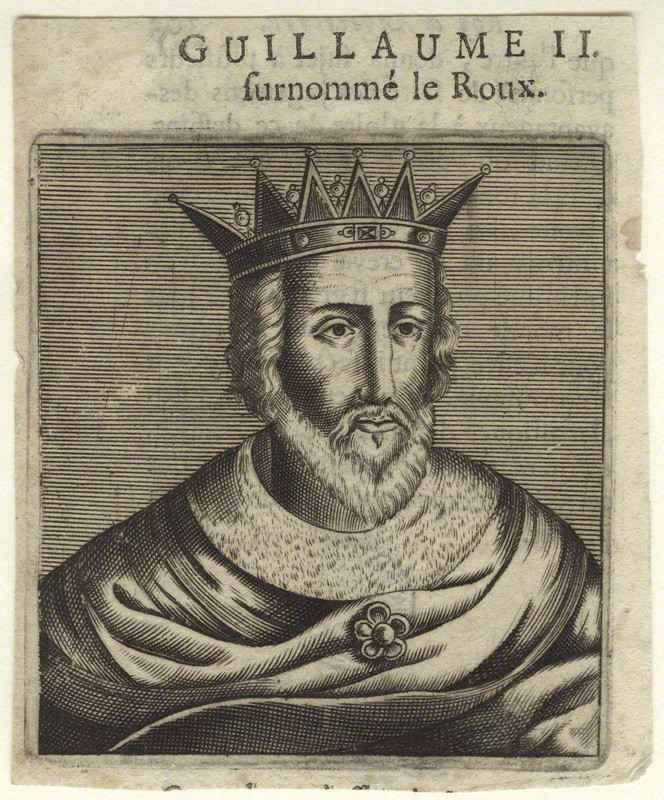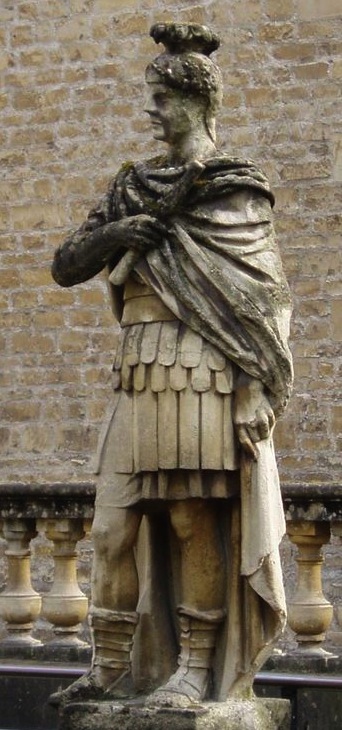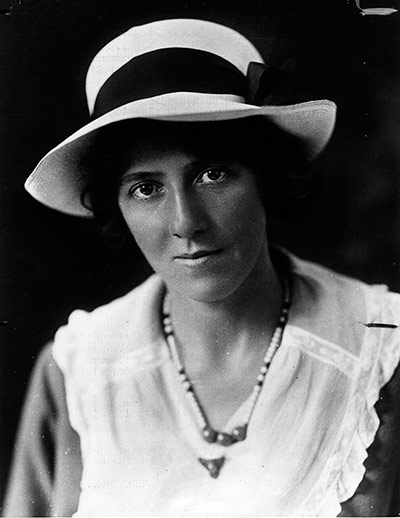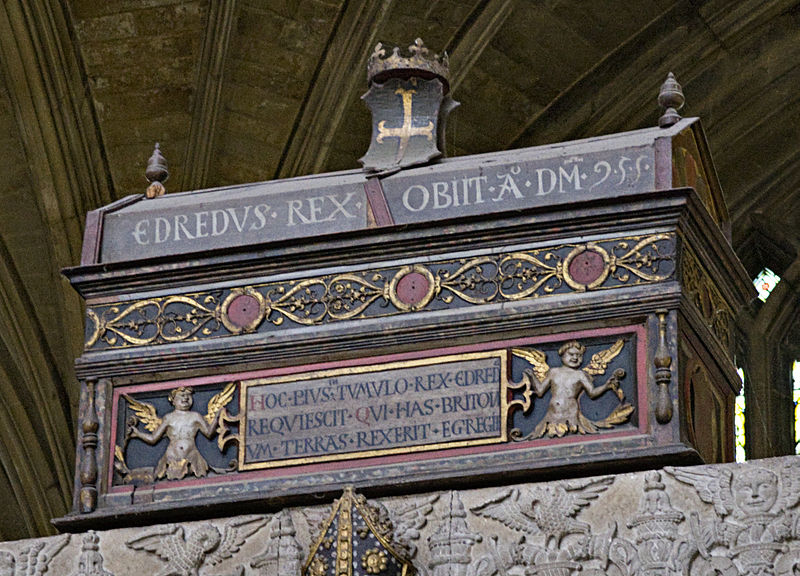Name: King Henry IV
Born: April 4, 1366 at Bolingbroke Castle, Lincolnshire
Parents: John of Gaunt and Blanche of Lancaster
Relation to Elizabeth II: 16th great-granduncle
House of: Lancaster
Ascended to the throne: September 30, 1399 aged 33 years
Crowned: October 13, 1399 at Westminster Abbey
Married: (1) Mary de Bohun, (2) Joan, Daughter of Charles II of Navarre
Children: Five sons including Henry V, and two daughters
Died: March 20, 1413 at Westminster Abbey, aged 46 years, 11 months, and 14 days
Buried at: Canterbury
Reigned for: 13 years, 5 months, and 18 days
Succeeded by: his son Henry V
King of England from 1399, the son of John of Gaunt. In 1398 he was banished by Richard II but returned in 1399 to head a revolt and be accepted as king by Parliament. He was succeeded by his son Henry V.
He had difficulty in keeping the support of Parliament and the clergy, and had to deal with baronial unrest and Owen Glendower’s rising in Wales. In order to win support he had to conciliate the Church by a law for the burning of heretics, and to make many concessions to Parliament. The Percy family was defeated at Shrewsbury in 1403, and the Earl of Northumberland was beaten at Bramham Moor in 1408.
| Timeline for King Henry IV |
| 1399 | Henry returns from exile in France to reclaim his estates seized by Richard II; he claims the throne and is crowned. His coronation was the first since the Norman Conquest in which the King’s address was in English instead of Norman French. |
| 1400 | Richard dies of starvation in Pontefract Castle. |
| 1400 | Death of the poet Geoffrey Chaucer leaving The Canterbury Tales unfinished. |
| 1401 | Owain Glyndwr leads Welsh revolt against English rule |
| 1402 | State visit to England of Manuel II, the Byzantine emperor |
| 1403 | First rebellion by the Percy family from Northumberland defeated at the Battle of Shrewsbury. |
| 1404 | Glyndwr makes a treaty with the French, who send an army in 1405 to support the rebellion against the English. |
| 1405 | Second Percy rebellion takes place |
| 1406 | Henry contracts a leprosy-like illness |
| 1408 | Third Percy rebellion takes place. |
| 1413 | Henry dies at Westminster, worn out by constant revolts and shortage of money. |
The House of Lancaster
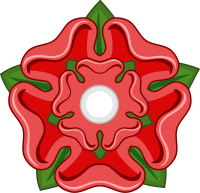 The House of Lancaster was established on England’s throne when Henry of Bolingbroke, the son of John of Gaunt (fourth son of Edward III) usurped the crown from his cousin King Richard II in 1399, marking the beginning the dynastic dispute which later came to be known as the Wars of the Roses. One of the badges of the house was the red rose.
The House of Lancaster was established on England’s throne when Henry of Bolingbroke, the son of John of Gaunt (fourth son of Edward III) usurped the crown from his cousin King Richard II in 1399, marking the beginning the dynastic dispute which later came to be known as the Wars of the Roses. One of the badges of the house was the red rose.
The dynasty ruled for three generations, encompassing the reign of Henry V, the conqueror of France, before the throne was taken from his son, the pious Henry VI, by the powerful rival House of York in 1461. The House of Lancaster became extinct in the direct male line on the death of Henry VI’s only son, Edward of Lancaster, during or after the Battle of Tewksbury in 1471.
Ancestry and Early Life
The future King Henry IV was born at Bolingbroke Castle in around April 1366, he was the son of John of Gaunt and Blanche Plantagenet, daughter and heiress of Henry, Duke of Lancaster, who was himself the descendant of Edmund Crouchback, Earl of Lancaster, the second son of Henry III. In common with his first cousin, Richard II, he therefore had a double Plantagenet descent.
The Parents of Henry IV
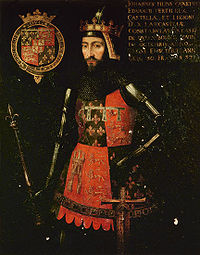 John of Gaunt, Shakespeare’s ‘time honoured Lancaster’ was the fourth son of Edward III . Henry’s mother, Blanche, Duchess of Lancaster was a beautiful and gracious woman, much admired by the poet Geoffrey Chaucer, who dedicated his Book of the Duchess to her. She and Gaunt produced two other surviving children, Phillipa and Elizabeth.
John of Gaunt, Shakespeare’s ‘time honoured Lancaster’ was the fourth son of Edward III . Henry’s mother, Blanche, Duchess of Lancaster was a beautiful and gracious woman, much admired by the poet Geoffrey Chaucer, who dedicated his Book of the Duchess to her. She and Gaunt produced two other surviving children, Phillipa and Elizabeth.
Following the death of his mother, Henry’s father remarried in political alliance with the Spanish Princess, Constanza, elder daughter of Pedro the Cruel of Castille, who held a claim to the throne of Castille, which John of Gaunt thereafter pursued. It was a loveless marriage, but nevertheless produced two children, a daughter Katherine, later to become Queen of Castille and a son, John, who died in infancy.
The young Bolingbroke was created a knight of the Garter by his grandfather, Edward III, on St.Georges Day 1377. At Richard II’s coronation later that year, his seven year old cousin played a prominent part, holding the sword of mercy, Curtana. Henry grew to a short but stocky man with red-brown hair, a red beard and brown eyes. Courageous and energetic, in common with many of the Plantagenet family, he was fond of music and song.
Following his marriage to Constanza, his father’s fate was inextricably interwoven with that of the Iberian peninsula. His sister Phillipa became Queen of Portugal. His half-sister, Katherine Plantagenet, whom Henry never met, due to her dynastic marriage to Henry III of Castille, was Queen Consort of Castile. He also had four half-siblings by his father’s marriage to his long term mistress, Katherine Swynford, whom John of Gaunt eventually married, resulting in their being declared legitimate by Richard II. His feelings toward Katherine Swynford, his second step-mother and the offspring of the marriage were mixed. He is recorded as disliking the fact that his former governess had taken his mother’s place. On his ascension to the throne, he revoked his half-brother, John Beaufort’s marquessate, and barred the possibility of the Beauforts ever inheriting the throne, but showed favour to Thomas Swynford, Katherine’s son by her first husband.
Henry of Bolingbroke was married in childhood to Mary de Bohun, the daughter and heiress of the renowned Humphrey de Bohun, Earl of Hereford and in her right held that title. He was also held the Earldom of Derby.
Henry had supported his cousin Richard II against three of the Lords Appellant and accused the fifth Lord Appellant, Mowbray, of treason, A trial by combat was decided upon to settle the issue but Richard intervened, preventing the duel, and banishing Henry for ten years. He later confiscated his cousin’s extensive estates and decreed the banishment should remain in force for life. On the death of his father in 1399, Henry landed at Ravenspur claiming he came to safeguard his inheritance, but actually came to take the throne from the cousin he now thoroughly detested.
Reign
Henry made the erroneous claim that his Lancastrian maternal ancestor, Edmund Crouchback, had been the elder son of Henry III, but had been overlooked because of his deformity in favour of Edward I. Richard met Henry’s representatives at Conway Castle and was informed that if he restored Henry’s estates and surrendered certain councillors for trial, he could remain in power. He agreed but was betrayed and instead of being returned to power found himself the inhabitant of a dungeon in the Tower.
A Parliament was called at the end of September, at which Henry claimed the throne. Richard was declared a tyrant and deposed. He was taken up to Pontefract Castle, in Yorkshire and there it is certain, he met his end around the second week in February, 1400. His skeleton was examined in 1871 by Dean Stanley of Westminster but showed no marks of violence. Starvation was the most likely cause of death, although this has never been proven.
Evil omens were said to have marked the coronation ceremony of the new king on 13th October, one of his golden spurs fell off, whispered to be a sure sign of impending rebellion. He needed no such warnings to underline the weakness of his situation. Henry took as his second wife Joan of Brittany, the widow of John IV of Brittany and the daughter of Charles II of Navarre. They married in 1403, the new queen was never popular with the people or the aristocracy.
Owain Glyndwr
A rebellion of Richard’s supporters arose after the new King’s coronation. The Welsh, under their leader, Owain Glyndwr, also rose in revolt. In 1400, Glyndwr proclaimed himself the true Prince of Wales and captured Conway Castle. Two years later the Welsh took Henry’s cousin, Edmund Mortimer prisoner. Mortimer, the Earl of March, was, by the strict laws of primogeniture, the true heir of Richard II, through his prior descent from Lionel of Antwerp, Duke of Clarence, the third son of Edward III, subsequently Henry was not in a hurry to secure his release.
Mortimer was supported by his brother-in-law, Henry Percy, known as Harry Hotspur who was married to his sister, Elizabeth Mortimer. Hotspur was the son of the Duke of Northumberland and Mary Plantagenet, a grandaughter of Edward III, making him the cousin of the King and of Richard II. The impulsive and fiery Hotspur marched to meet the king’s army, their forces clashed at the Battle of Shrewsbury on 21st July 1403.
The Battle of Shrewsbury
As Hotspur and his uncle, Thomas Percy, Earl of Worcester, along with their Scottish ally, Archibald, Earl of Douglas, advanced on Shrewsbury, the town was garrisoned by the king’s eldest son, Henry, Prince of Wales, the future Henry V. The king himself marched a force to intercept Harry Hotspur before he could join forces with Glyndwr.
The Battlefield at Shrewsbury
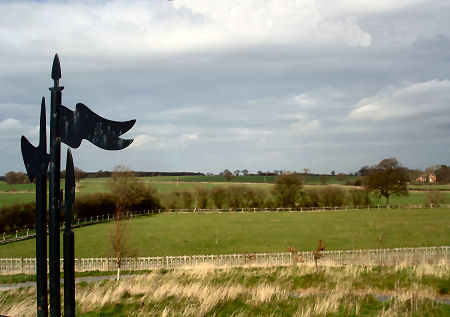
Henry IV arrived at Shrewsbury a short while before Hotspur on the 20th July. The following morning, ominously, Glyndwr had still not arrived with reinforcements, perhaps taken by surprise at the speed of the King’s advance. The Royal army marched out of the town to meet the rebels at Haytely Field, about three miles from the centre of the town on the road to Whitchurch. Estimates regarding the sizes of the two armies vary widely, the King’s army, which far outnumbered that of the rebels, is generally considered to be between 15,000 and 60,000 men, while the rebels numbered between 5,000 and 20,000.
Parleys were entered into, which failed to result in an acceptable agreement, rendering battle inevitable. By around the hour of noon the order for advance was given and battle commenced.
The assault was opened with a deadly exchange of arrows, a dread and whirring cacophany which resulted in many casualties on both sides. The Prince of Wales was wounded in the face with an arrow, but staunchly refused to retire from the field. When the two armies clashed, the larger Royal army began to gain the upper hand, although the Earl of Stafford, who lead the centre of the King’s army was killed in the fighting. Harry Hotspur fell whilst leading a rash and impulsive charge, as a result of an arrow hitting his forehead, entering his brain.
View of the battlefield
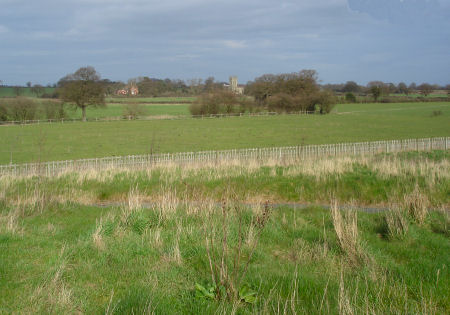 Morale in the rebel army suffered as a result of Hotspur’s death and as dusk began to fall on the battlefield, the rebels fled, resulting in a general rout. Huge casualties were suffered by both sides, mainly as the result of the use of the English longbow, which enabled archers to fire twelve arrows a minute. A contemporary wrote of the conflict-:
Morale in the rebel army suffered as a result of Hotspur’s death and as dusk began to fall on the battlefield, the rebels fled, resulting in a general rout. Huge casualties were suffered by both sides, mainly as the result of the use of the English longbow, which enabled archers to fire twelve arrows a minute. A contemporary wrote of the conflict-:
‘A more stubborn fight, it is maintained by those who were present was never known. Very many of the combatants on both sides struggled with such obstinacy that when night came on they did not know which side had won: and they sank down in all directions a chance medley of weary, wounded, bruised and bleeding men.’
The body of Hotspur was recovered in the gathering twilight, the king is said to have wept over the body of his cousin. An eclipse of the moon that night cast an eerie blackness over the desolate field, which was littered with the dead and the dying.
Henry IV at first allowed Hotspur’s body to be interred at Whitchurch. In response to rumours that he had survived the battle, his attitude hardened and he had it disinterred. Hotspur’s body was set up in Shrewsbury, impaled on a spear between two millstones, and was later quartered, its parts dispatched to seperate locations in the kingdom, his head impaled on a pike at the gates of York, a grim warning of the king’s terrible retribution to others. The Earl of Worcester was taken alive but later beheaded and his head set up on a spike on London Bridge.
Battlefield Church, Shrewsbury, built at the behest of Henry IV, for the souls of those killed in the battle
 Battlefield Church, otherwise known as St. Mary Magdalene, was built in 1406 at the behest of King Henry, where daily masses where said for the souls of those who fell. Said to stand over the mass grave in which the many dead were buried, it is a commemorative monument, similar in sentiment to Battle Abbey in Sussex, built by Wiliam the Conqueror on the site of the Battle of Hastings.
Battlefield Church, otherwise known as St. Mary Magdalene, was built in 1406 at the behest of King Henry, where daily masses where said for the souls of those who fell. Said to stand over the mass grave in which the many dead were buried, it is a commemorative monument, similar in sentiment to Battle Abbey in Sussex, built by Wiliam the Conqueror on the site of the Battle of Hastings.
Rebellion broke out again in Wales, headed by Owain Glyndwr, a man of charisma and great ability, who forged an alliance with the French. Henry of Monmouth, the English Prince of Wales, went on to subdue the country and Glyndwr went into hiding. Never captured, he mysteriously disappeared from the pages of history and became a national hero amongst the Welsh people. Nothing is recorded of him after 1412. Huge rewards were offered by the crown which failed to bring about his capture. Tradition states that he either died at his estate in Sycharth or on the estates of one of his daughters’ husbands.
The Death of Henry IV
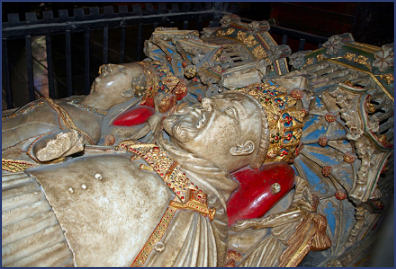 In the latter part of his reign Henry was struck by a disfiguring disease, which forced him to become a recluse. The Prince of Wales, who the king considered too eager to step into his shoes, was given control of the government along with a council.
In the latter part of his reign Henry was struck by a disfiguring disease, which forced him to become a recluse. The Prince of Wales, who the king considered too eager to step into his shoes, was given control of the government along with a council.
The king’s health steadily deteriorated, he contracted a form of skin disease, variously considered to be leprosy, syphilis or psoriasis.
The attacks he suffered from have been the subject of a wide range of theories which it is impossible to confirm, they range from epilepsy to a form of cardiovascular disease. Henry suffered a seizure whilst praying at St. Edward’s shrine at Westminster and was carried to the to the abbot’s house. The first King of the House of Lancaster died on 20th of March 1413, aged forty-six, in the Jerusalem chamber at Westminster. During his lifetime it had been predicted that Henry would die in Jerusalem. The king himself took this to mean that he would die on Crusade.
He was not buried at Westminster, the traditional mausoleum of English kings, but at Canterbury Cathedral, in the Trinity Chapel, near to the shrine of Thomas A’ Becket and opposite the tomb of the Black Prince. During Henry’s reign, the cult of St. Thomas Becket was extremely popular and Henry was particularly devoted to Becket. His widow, Joan of Brittany, had an altar tomb built over the spot.
Queen Joan herself was later accused of necromancy by her step-son, Henry V and was imprisoned by him in Leeds Castle. Being released by Henry on his deathbed, she lived on until 1437, when she was laid to rest in the tomb of her husband in Canterbury Cathedral.
The children and grandchildren of Henry IV and Mary de Bohun
(1) HENRY V (1387-1422) m. Catherine of Valois
Issue:-
(i) HENRY VI (1421 – 1461)
(2) John Duke of Bedford (1389-1435) m. (i)Anne of Burgundy (ii) Jacquetta of Luxembourg
No issue
(3) Thomas Duke of Clarence (1388-1421) m. Margaret Holland
No issue
(4) Humphrey Duke of Gloucester (1390-1447) m. (i) Jacqueline of Holland (ii) Eleanor de Cobham
No issue
(5) Blanche (1392-1409) m. Louis III, Elector Palatine
(i) Rupert of the Palatine (1406 – 1426)
(6) Phillipa (1394-1430) m. Eric IX of Denmark
Credits:
Wikipedia
http://www.englishmonarchs.co.uk/
http://www.britroyals.com/

